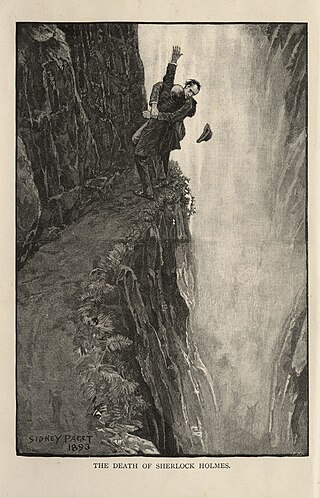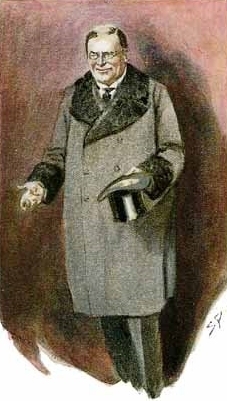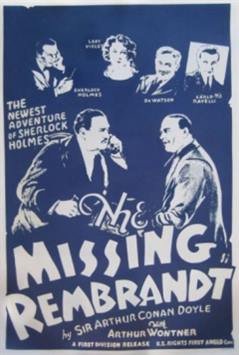
Mycroft Holmes is a fictional character appearing in stories written by Sir Arthur Conan Doyle from 1893 to 1908. The elder brother of detective Sherlock Holmes, he is a government official and a founding member of the Diogenes Club. Mycroft is described as having abilities of deduction and knowledge exceeding even those of his brother, though their practical use is limited by his dislike of fieldwork.

"The Final Problem" is a short story by Sir Arthur Conan Doyle featuring his detective character Sherlock Holmes. It was first published in The Strand Magazine in the United Kingdom, and McClure's in the United States, under the title "The Adventure of the Final Problem" in December 1893. It appears in book form as part of the collection The Memoirs of Sherlock Holmes.

"The Adventure of the Empty House", one of the 56 Sherlock Holmes short stories written by Sir Arthur Conan Doyle, is one of 13 stories in the cycle collected as The Return of Sherlock Holmes. It was first published in Collier's in the United States on 26 September 1903, and in The Strand Magazine in the United Kingdom in October 1903.

The Valley of Fear is the fourth and final Sherlock Holmes novel by British writer Arthur Conan Doyle. It is loosely based on the Molly Maguires and Pinkerton agent James McParland. The story was first published in the Strand Magazine between September 1914 and May 1915. The first book edition was copyrighted in 1914, and it was first published by George H. Doran Company in New York on 27 February 1915, and illustrated by Arthur I. Keller.

Detective Inspector G. Lestrade, or Mr. Lestrade, is a fictional character appearing in several of the Sherlock Holmes stories written by Arthur Conan Doyle. Lestrade's first appearance was in the first Sherlock Holmes story, the novel A Study in Scarlet, which was published in 1887. The last story in which he appears is the short story "The Adventure of the Three Garridebs", which was first published in 1924 and was included in the final collection of Sherlock Holmes stories by Doyle, The Case-Book of Sherlock Holmes.

"The Adventure of Charles Augustus Milverton" is one of the 56 Sherlock Holmes short stories written by Sir Arthur Conan Doyle. It was originally published in Collier's in the United States on 26 March 1904, and in The Strand Magazine in the United Kingdom in April 1904. It is one of 13 stories in the cycle collected as The Return of Sherlock Holmes (1905).

Colonel Sebastian Moran is a fictional character in the stories written by Arthur Conan Doyle. An enemy of Sherlock Holmes, he first appears in the 1903 short story "The Adventure of the Empty House". Holmes once described him as "the second most dangerous man in London", the most dangerous being Professor Moriarty, Moran's employer.
The stories of Sherlock Holmes by Sir Arthur Conan Doyle have been very popular as adaptations for the stage, and later film, and still later television. The four volumes of the Universal Sherlock Holmes (1995) compiled by Ronald B. De Waal lists over 25,000 Holmes-related productions and products. They include the original writings, "together with the translations of these tales into sixty-three languages, plus Braille and shorthand, the writings about the Writings or higher criticism, writings about Sherlockians and their societies, memorials and memorabilia, games, puzzles and quizzes, phonograph records, audio and video tapes, compact discs, laser discs, ballets, films, musicals, operettas, oratorios, plays, radio and television programs, parodies and pastiches, children's books, cartoons, comics, and a multitude of other items — from advertisements to wine — that have accumulated throughout the world on the two most famous characters in literature."
Sherlock Holmes has long been a popular character for pastiche, Holmes-related work by authors and creators other than Arthur Conan Doyle. Their works can be grouped into four broad categories:
Arthur Wontner was a British actor best known for playing Sir Arthur Conan Doyle's master detective Sherlock Holmes in five films from 1931 to 1937.

The Adventures of Sherlock Holmes is a 1939 American mystery adventure film based on Sir Arthur Conan Doyle's Sherlock Holmes detective stories. Although claiming to be an adaptation of the 1899 play Sherlock Holmes by William Gillette, the film bears little resemblance to the play.

Sherlock Holmes and the Deadly Necklace is a 1962 mystery film directed by Terence Fisher. It is a West German-French-Italian international co-production. The film starred Christopher Lee as Sherlock Holmes and Thorley Walters as Dr. Watson. Curt Siodmak wrote the screenplay, based on characters created by Sir Arthur Conan Doyle.

Ian Fleming was an Australian character actor with credits in over 100 British films. One of his best known roles was playing Dr Watson in a series of Sherlock Holmes films of the 1930s opposite Arthur Wontner's Holmes.

The Sign of Four is a 1932 British crime film directed by Graham Cutts and starring Arthur Wontner, Ian Hunter and Graham Soutten. The film is based on Arthur Conan Doyle's second Sherlock Holmes novel The Sign of the Four (1890). The film is also known as The Sign of Four: Sherlock Holmes' Greatest Case.

Silver Blaze is a 1937 British, black-and-white crime and mystery film, based loosely on Arthur Conan Doyle's 1892 short story "The Adventure of Silver Blaze". It was directed by Thomas Bentley, and was produced by Twickenham Film Studios Productions. It stars Arthur Wontner as Sherlock Holmes, and Ian Fleming as Dr. Watson. In the United States, the film was released in 1941 by Astor Pictures, where it was also known as Murder at the Baskervilles, retitled by distributors to capitalize on the success of the Basil Rathbone Holmes film, The Hound of the Baskervilles.

The Adventures of Sherlock Holmes and Dr. Watson is a 1980 Soviet film adaptation of Arthur Conan Doyle's stories about Sherlock Holmes. It is the second film in The Adventures of Sherlock Holmes and Dr. Watson film series directed by Igor Maslennikov.

The Triumph of Sherlock Holmes is a 1935 British mystery film directed by Leslie S. Hiscott and starring Arthur Wontner. It was based on the 1915 Sherlock Holmes novel The Valley of Fear by Arthur Conan Doyle.

The Speckled Band is a 1931 British mystery film directed by Jack Raymond and starring Lyn Harding, Raymond Massey and Angela Baddeley. It is an adaptation of Arthur Conan Doyle's original 1892 story "The Adventure of the Speckled Band" and the 1910 play he adapted from it, The Speckled Band.

The Missing Rembrandt is a 1932 British mystery film directed by Leslie S. Hiscott and starring Arthur Wontner, Jane Welsh, Miles Mander, and Francis L. Sullivan. It is considered a lost film. The film was loosely based on the 1904 Sherlock Holmes story "The Adventure of Charles Augustus Milverton" by Arthur Conan Doyle.
Sherlock Holmes is a film series running from 1931 to 1937. Arthur Wontner portrayed Sherlock Holmes in five films.
















